1lumen selects and reviews products personally. We may earn affiliate commissions through our links, which help support our testing.
Sofirn HS40 review
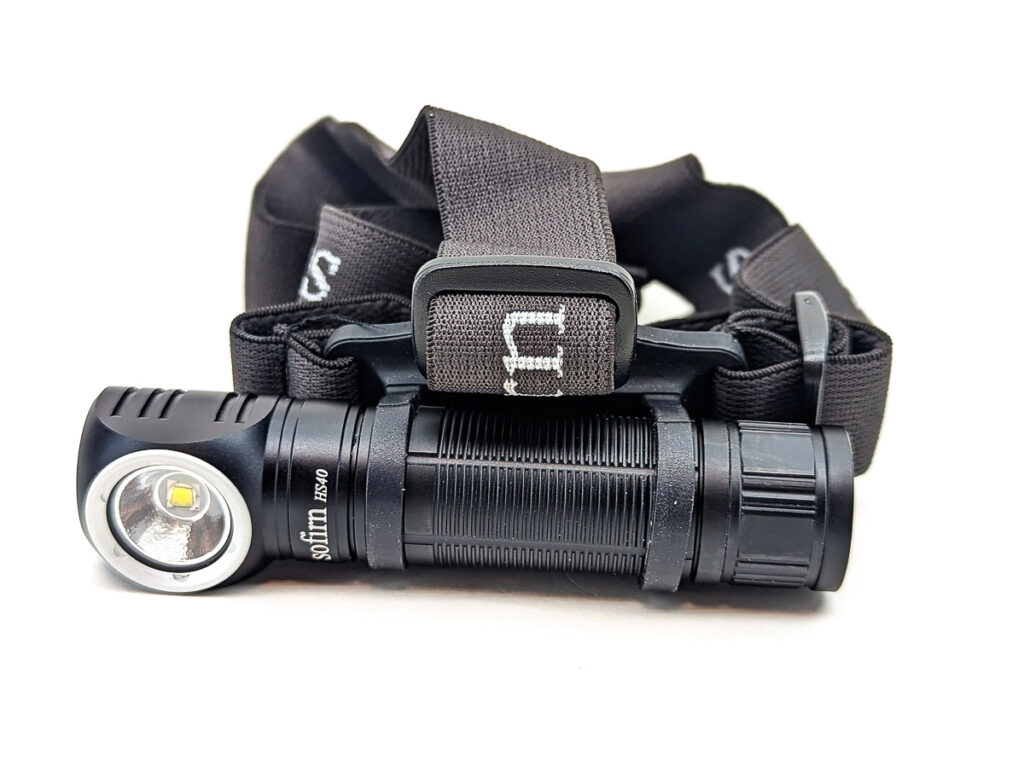
Sofirn HS40 specifications
| Brand & Model | Sofirn HS40 |
|---|---|
| Flashlight category | best headlamp |
| LED | SST40 |
| Max. output | 2000 lumens |
| Max. beam distance | 175 meters |
| Max. beam intensity | 7625 cd |
| Battery config. | 1x 18650 |
| Onboard charging | USB-C |
| Modes | 5 |
| Blinkies | Strobe / SOS / Beacon |
| Waterproof | IPX8 |
| Review publication date | February 2023 |
Introduction:
If you’ve spent any time in the budget-minded side of the flashlight enthusiast world, you’ve certainly run across the Sofirn brand. They’ve been around since 2016-2017, and seemingly had some roots in what was ThorFire back in the day. I don’t know what the exact relationship was, but I know a few ThorFire models seemed to fade into Sofirn models (eg, the Q8). And nowadays Sofirn seems to also have some sort of corporate relationship to Wurkkos (sister company? shared ODM?). Whatever those relationships are, it’s fair to say that Sofirn has been heavily involved in the budget flashlight space.
Several Sofirn models, particularly early ones, have had decent buck drivers and simple UIs. Then… Sofirn hopped aboard the Anduril train. I really like Anduril (after all, I contribute to the source code), but it’s not for everyone – especially considering that almost all Anduril drivers rely on FET designs which can generate a lot of heat. That’s one reason why I’m anxious to check out the Sofirn HS40 headlamp, which employs a simple UI – perhaps we’ll have another more-efficient buck driver on our hands for better regulation?
Package quality.
The Sofirn HS40 arrived in a very Sofirn-looking package, typical of their non-tube lights. It’s a brown cardboard box with bold “Sofirn” lettering across the top. Nestled inside the foam-lined box was:
- Sofirn HS40
- Battery
- Short (18350) tube
- Pocket clip
- Head strap
- Charging cable
- Spare o-rings
- Manual
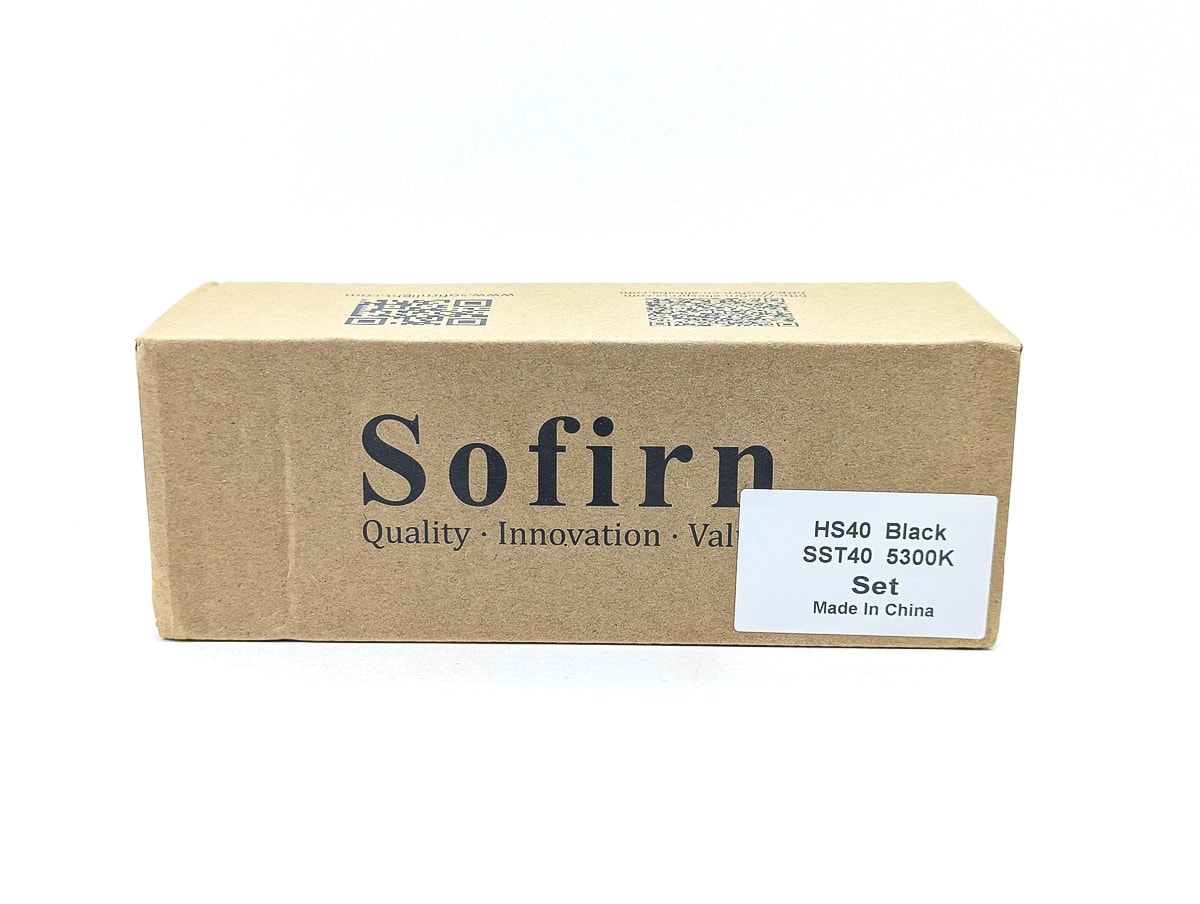
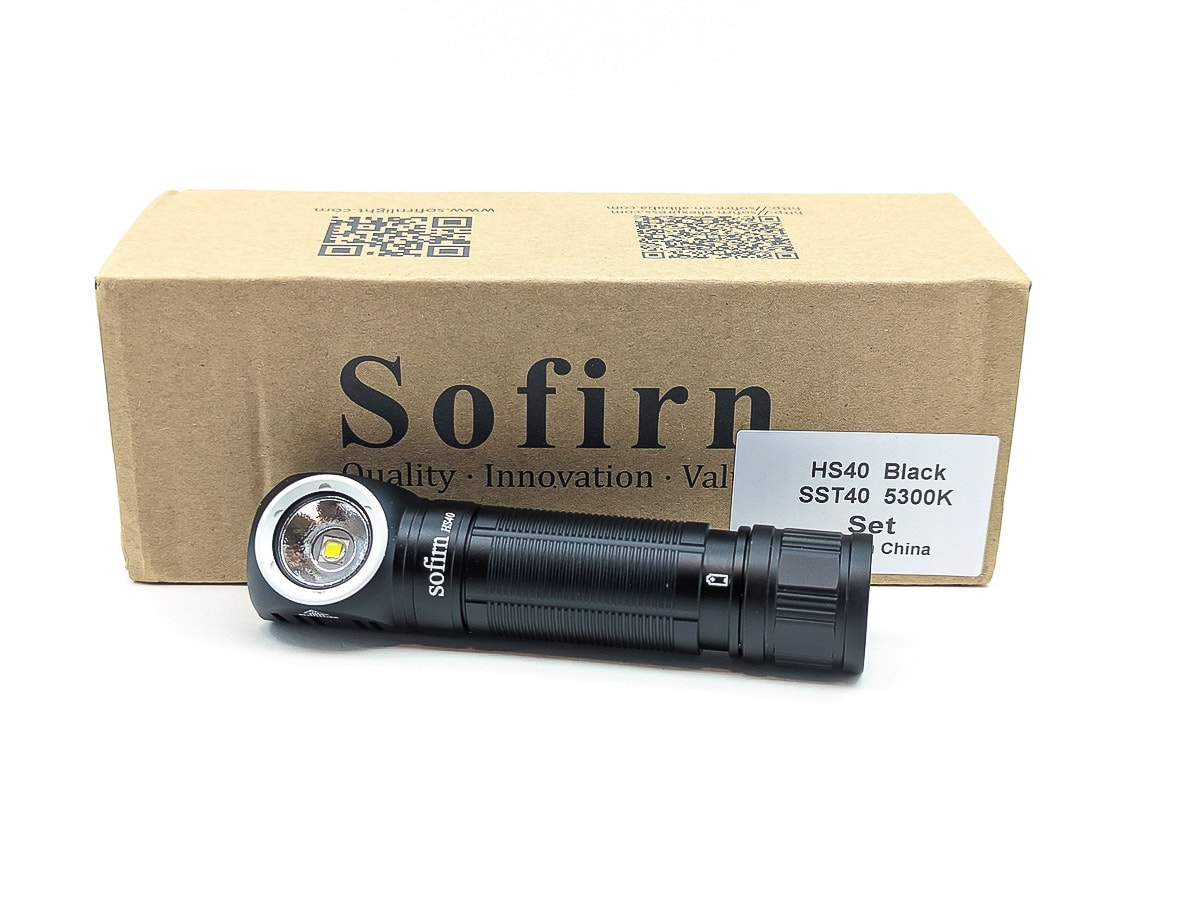
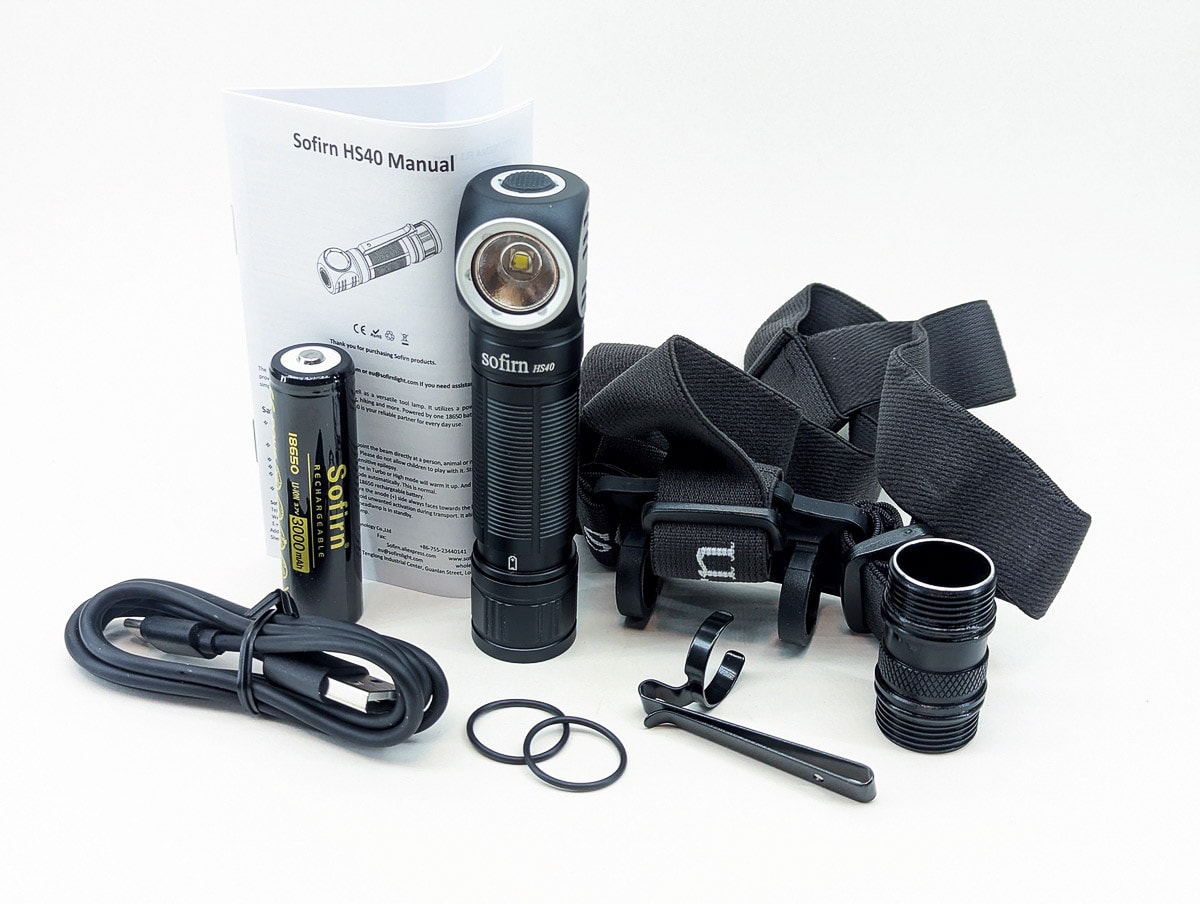
Headlamp in use
Headlamps come in a few different body styles. The two prominent ones are right-angle (L-shaped) and T-shaped. They both have their advantages. T-shaped lights can feel more balanced when they’re on your head, so they’re great for dedicated headlamp use. Right-angle lamps work fairly well on your head, but also do well as utility / work lights. The Sofirn HS40 falls into the latter category.
The HS40 comes with an 18650 battery, making it a moderately-sized headlamp. If you prefer smaller/lighter things strapped to your head, the included 18350 tube helps with that. There’s a single e-switch for controlling the operation, which sits on the end of the headlamp. It’s my personal preference, but I like having the button on the side of the head so the light can be activated with a pinching motion. Having it on the end works ok though. The button is just barely proud of the end of the light. There’s a USB-C port opposite the reflector; it’s covered by a plug that sits mostly flush with the body.
The headstrap is the style that includes an over-the-top strap. Overall, the strap feels like pretty standard stuff. It’s stretchy and lightweight, but lacks the grippy stripes that you find on some nicer headbands. The mount area consists of a couple rubbery rings that are easy to slip over the body of the HS40 and allow you to install and remove the light without much trouble. During my testing, it stayed in place on my head just fine while bouncing and moving around.
The included two-way pocket clip is a pretty typical Sofirn-esque clip. Not only is the clip bi-directional, but if you prefer it to physically be flipped around, you can do so by flipping the battery tube around. Doing that works just fine and makes good electrical connections. However, do note that the battery tube has a directional battery reminder engraved on it. I’m sure none of you would flip the tube and then think the battery needs to go with the negative pole toward the flashlight head… but I’ve heard of sillier happenings.
A headlamp such as the Sofirn HS40 is great for all kinds of things: working around the house/garage/yard, hiking in the evening, hunting/fishing, etc. If I’m going to be working on something with my hands up-close (eg, electric work when you’ve got the circuit breaker off), then I prefer a T-shaped headlamp. But for outdoor activities, the HS40 is great. Oh, and I forgot to mention that the tailcap is magnetic. That means instead of having it mounted to your head, you can position it as a worklight – pretty handy.
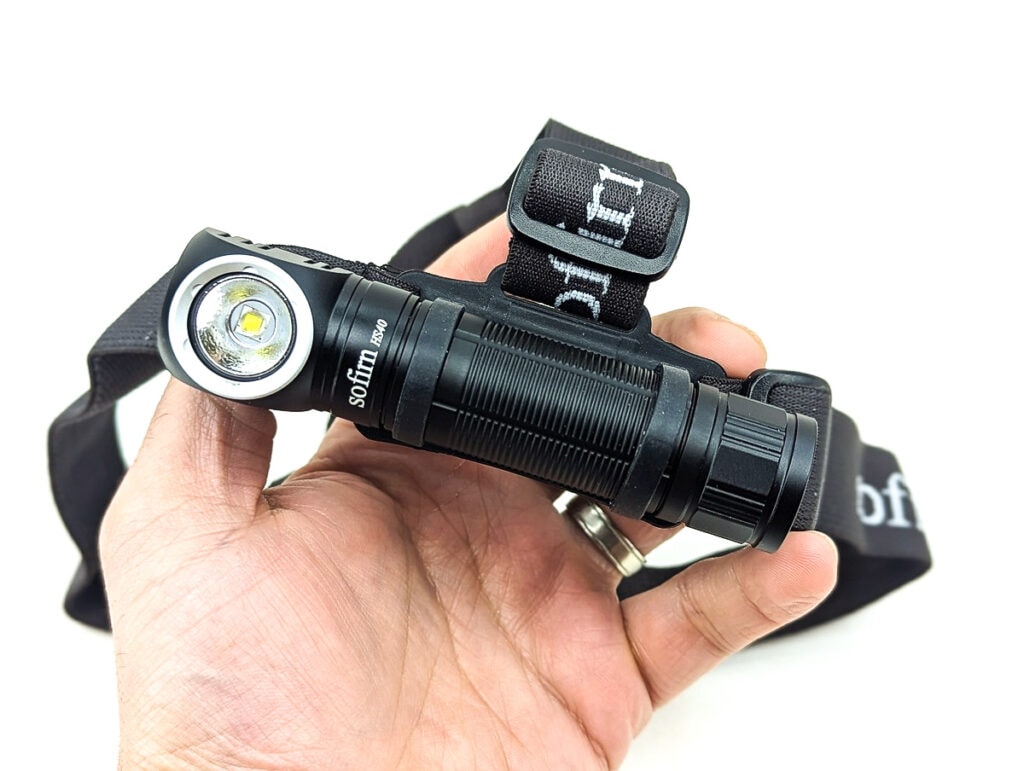
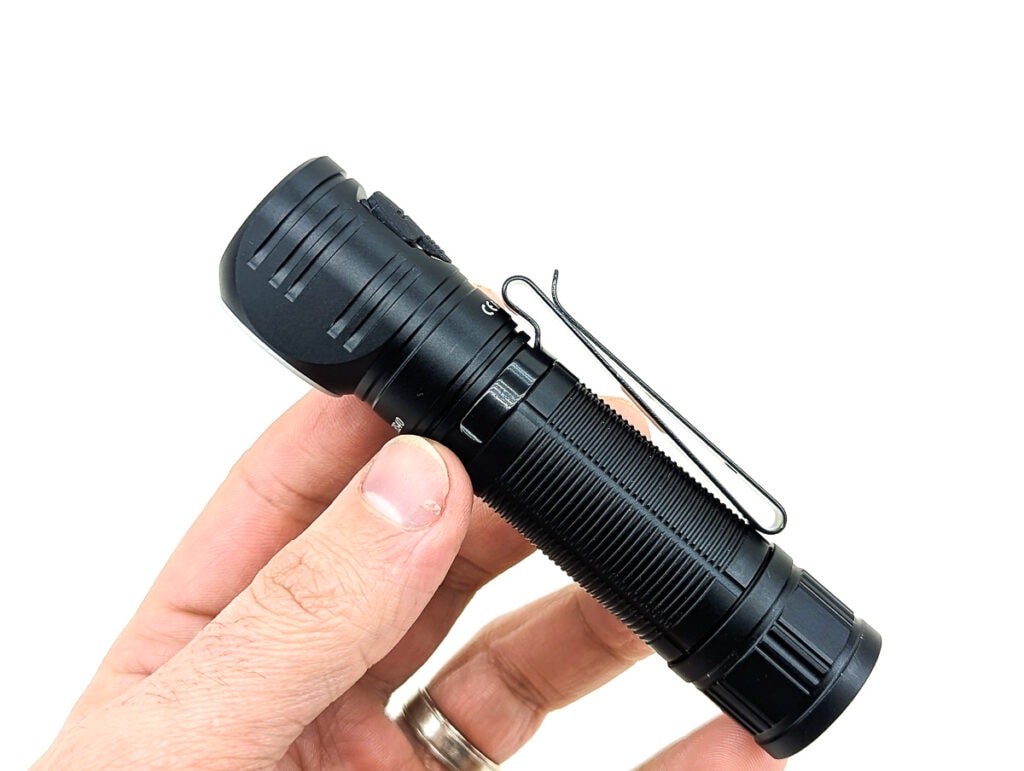
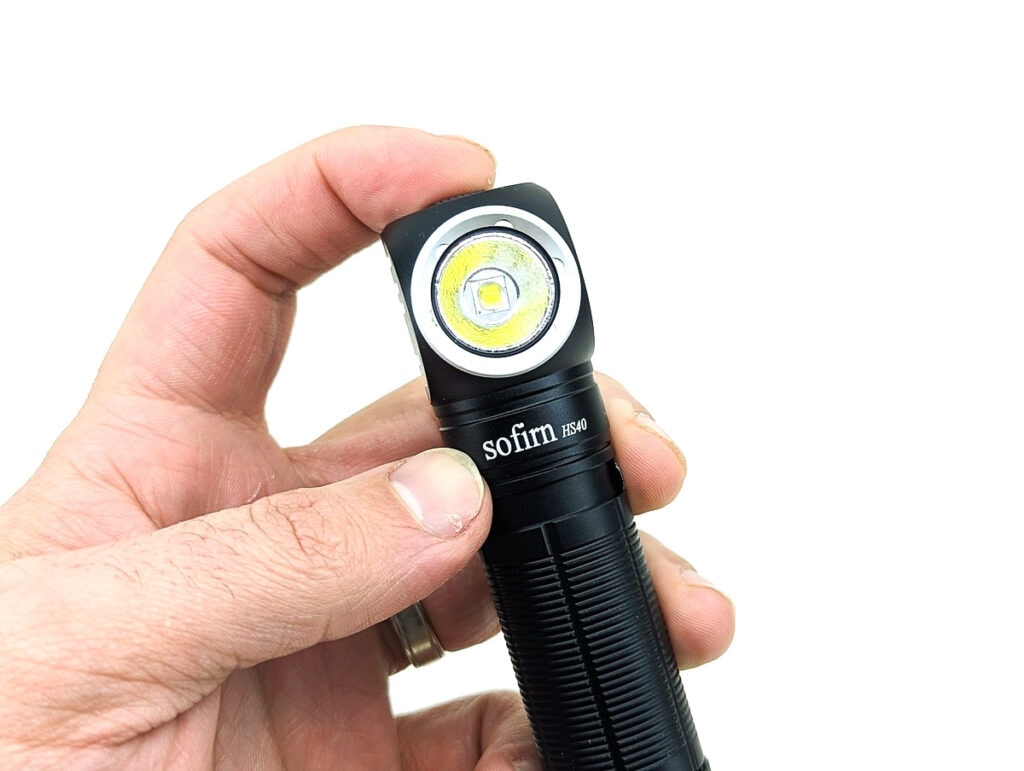
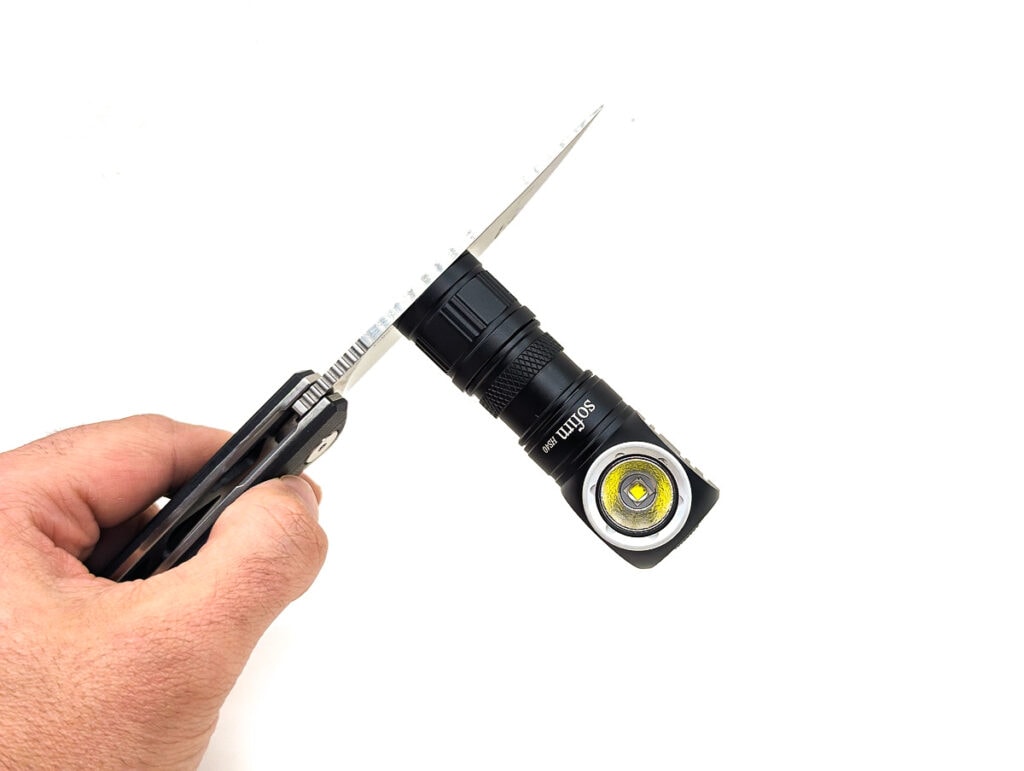
Build Quality and Warranty
The Sofirn HS40 is CNC’ed from a piece of aerospace-grade 6061 aluminum. It is said to be Hard Anodized Type III (HA III). If you’ve ever had a black Sofirn light, you should be familiar with the overall appearance of the anodizing – it’s not really shiny, but not exactly matte either. The machining is quite smooth and the heat sink edges have a very minor chamfer to them, just enough to keep them from feeling rough. The threads at each end of the battery tube are anodized, square-cut, lubed, and very smooth feeling.
Sofirn’s warranty is as follows:
- Within 30 days of purchase: Contact the original seller for repair or replacement.
- Within 1 year of purchase: Contact Sofirn for repair or replacement.
- (Batteries) Within 1/2 year of purchase: Contact Sofirn for repair or replacement.

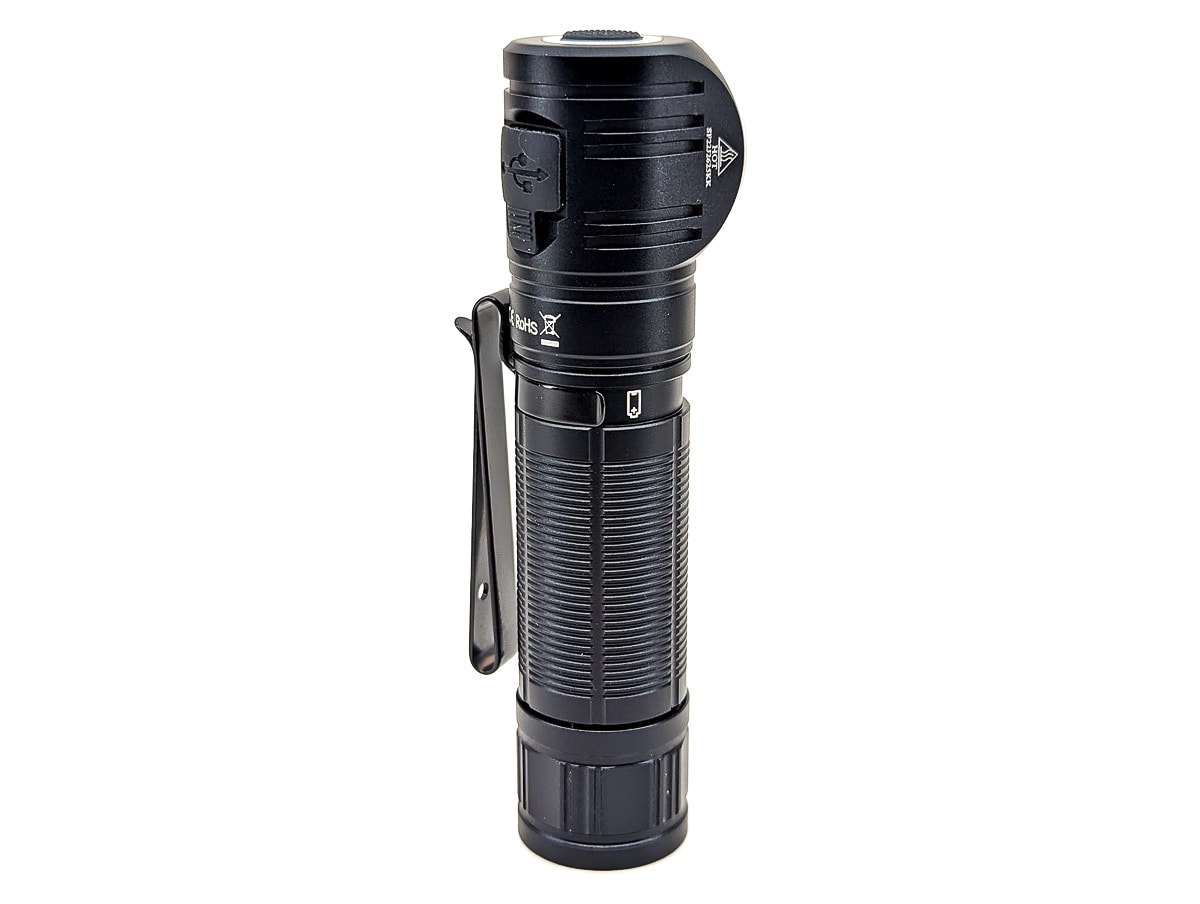
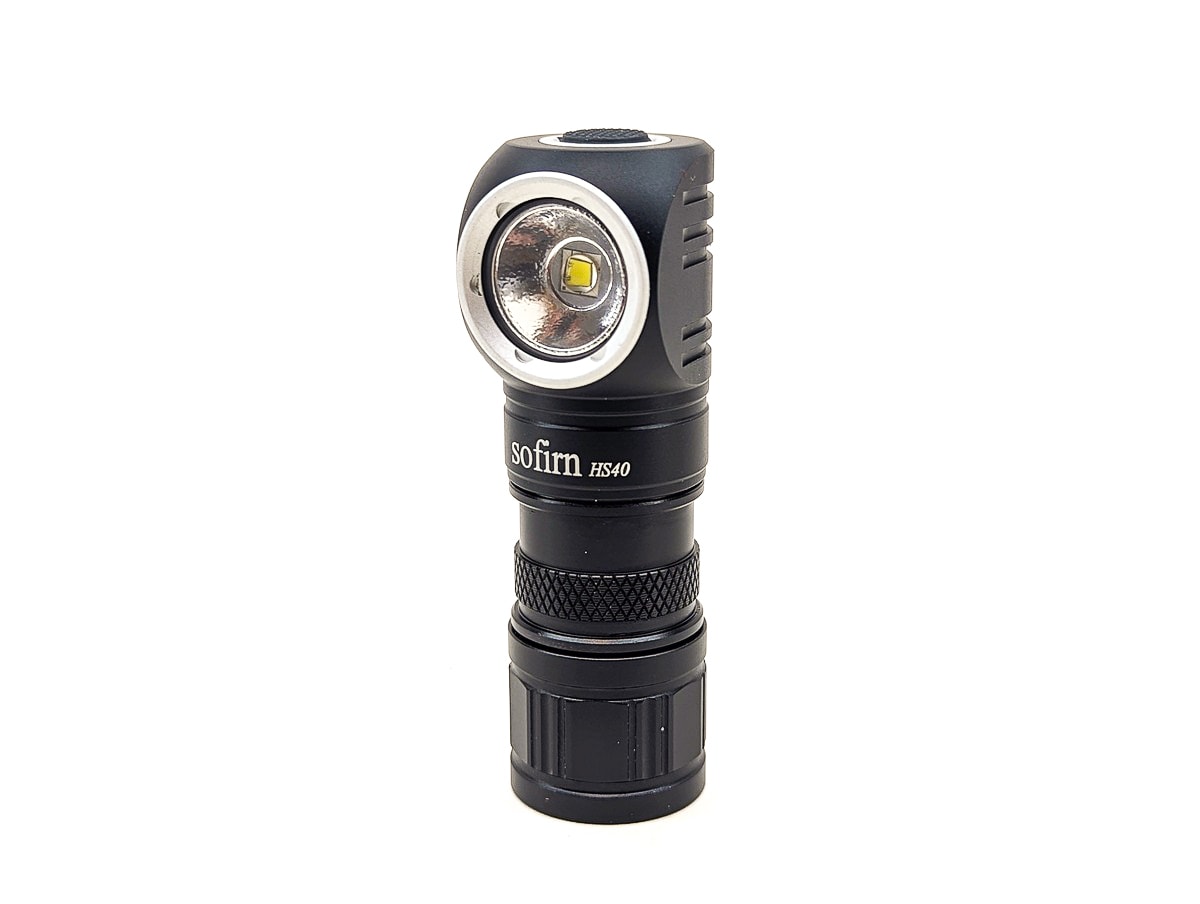
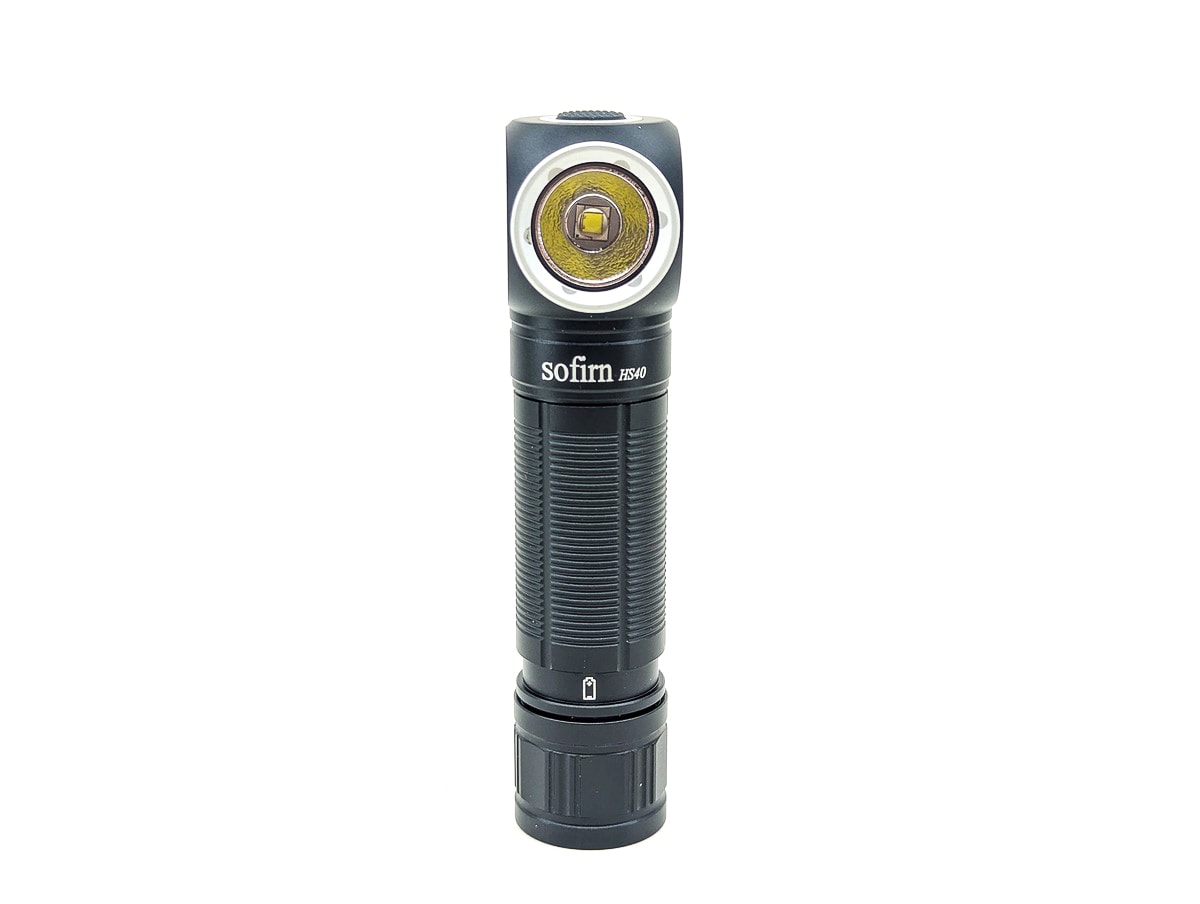
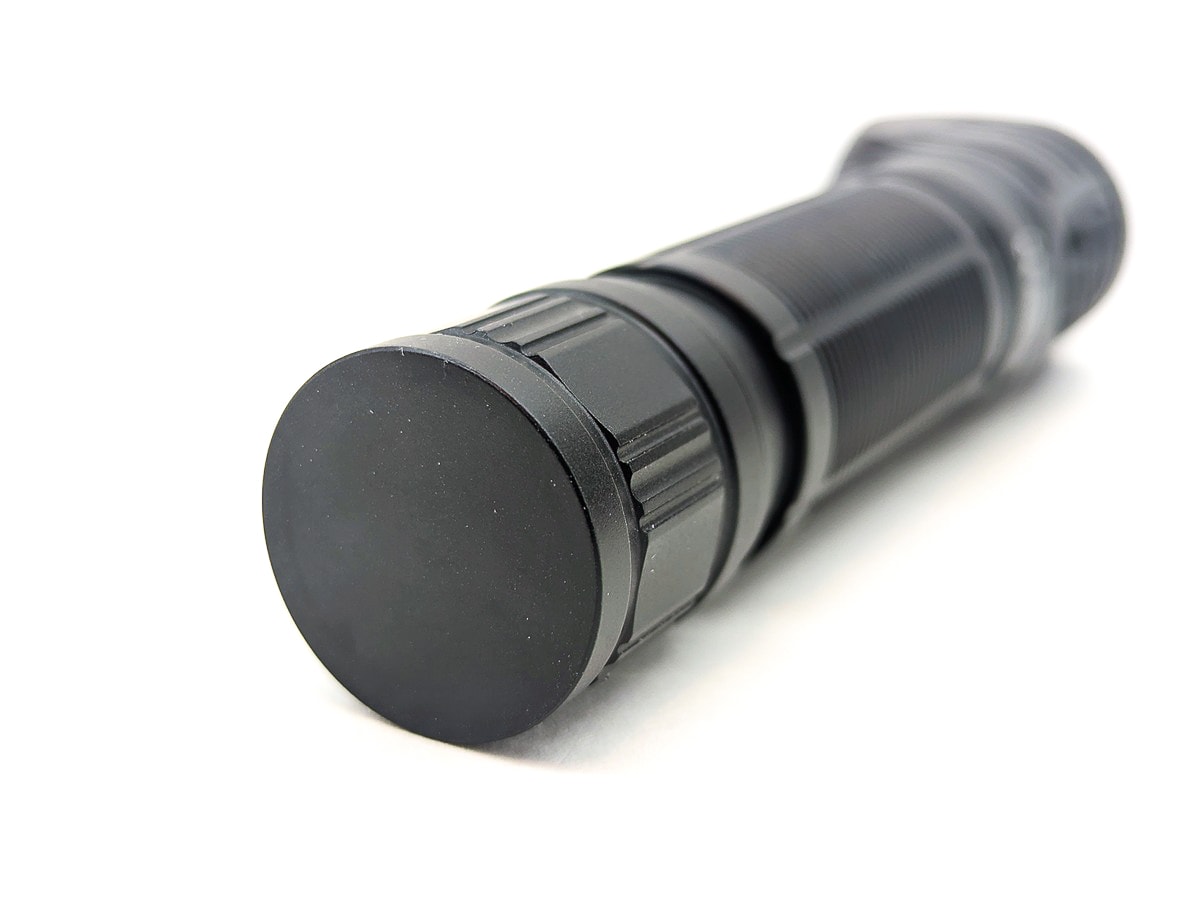
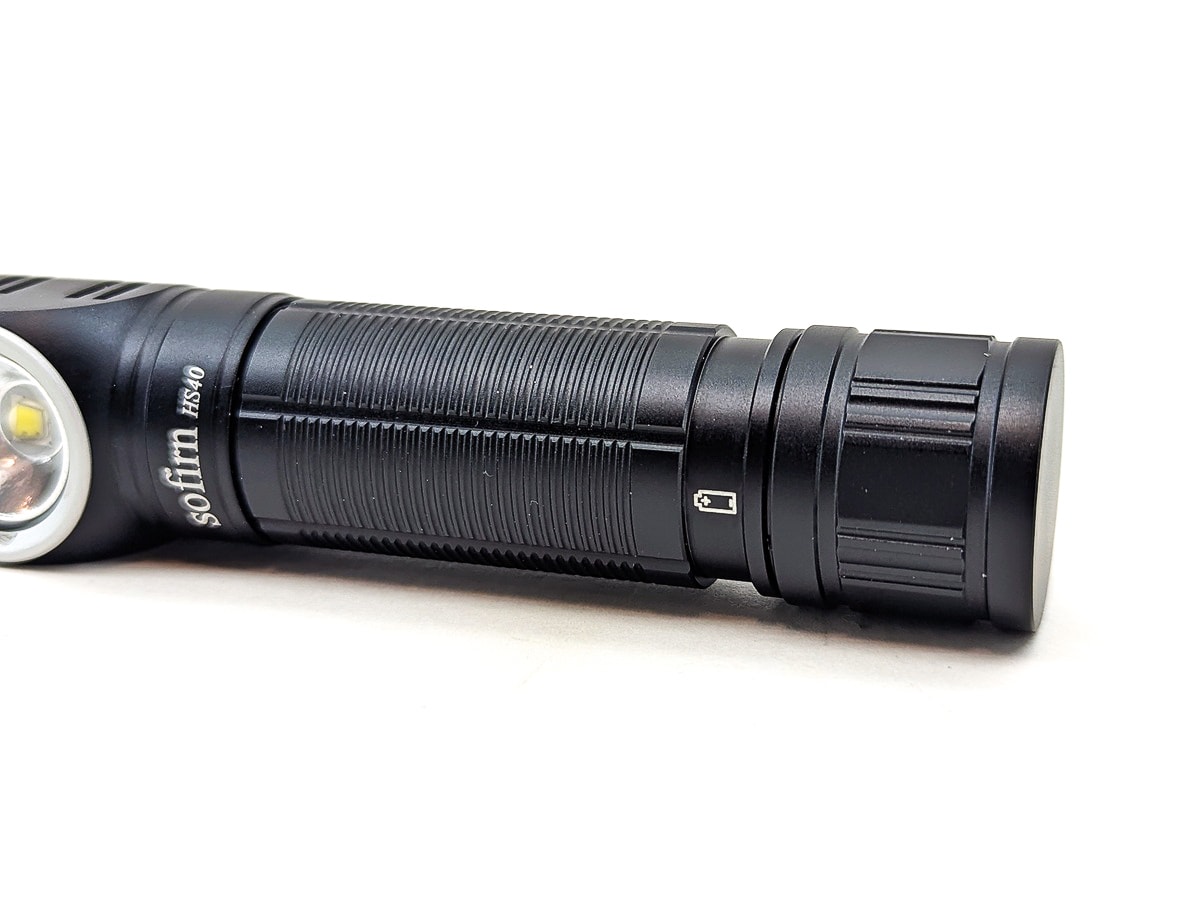
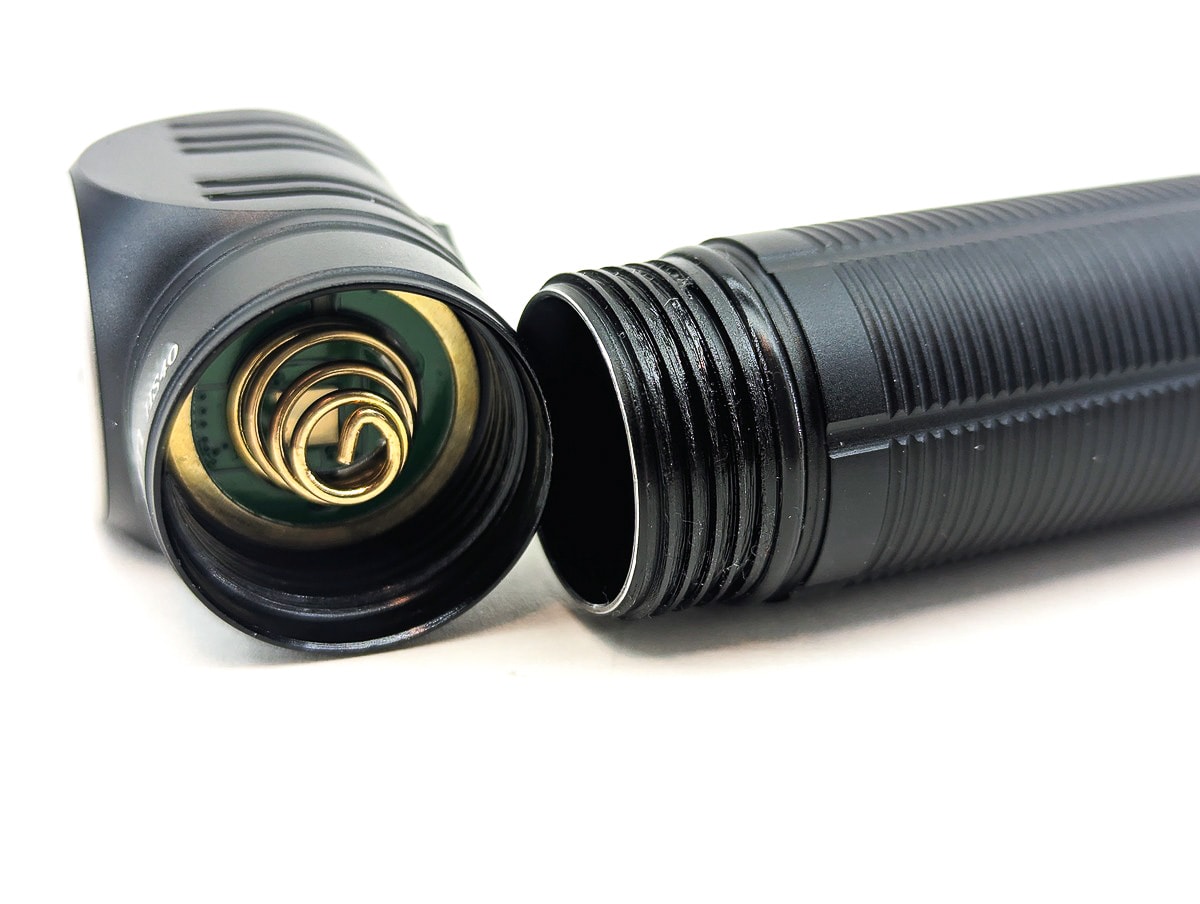
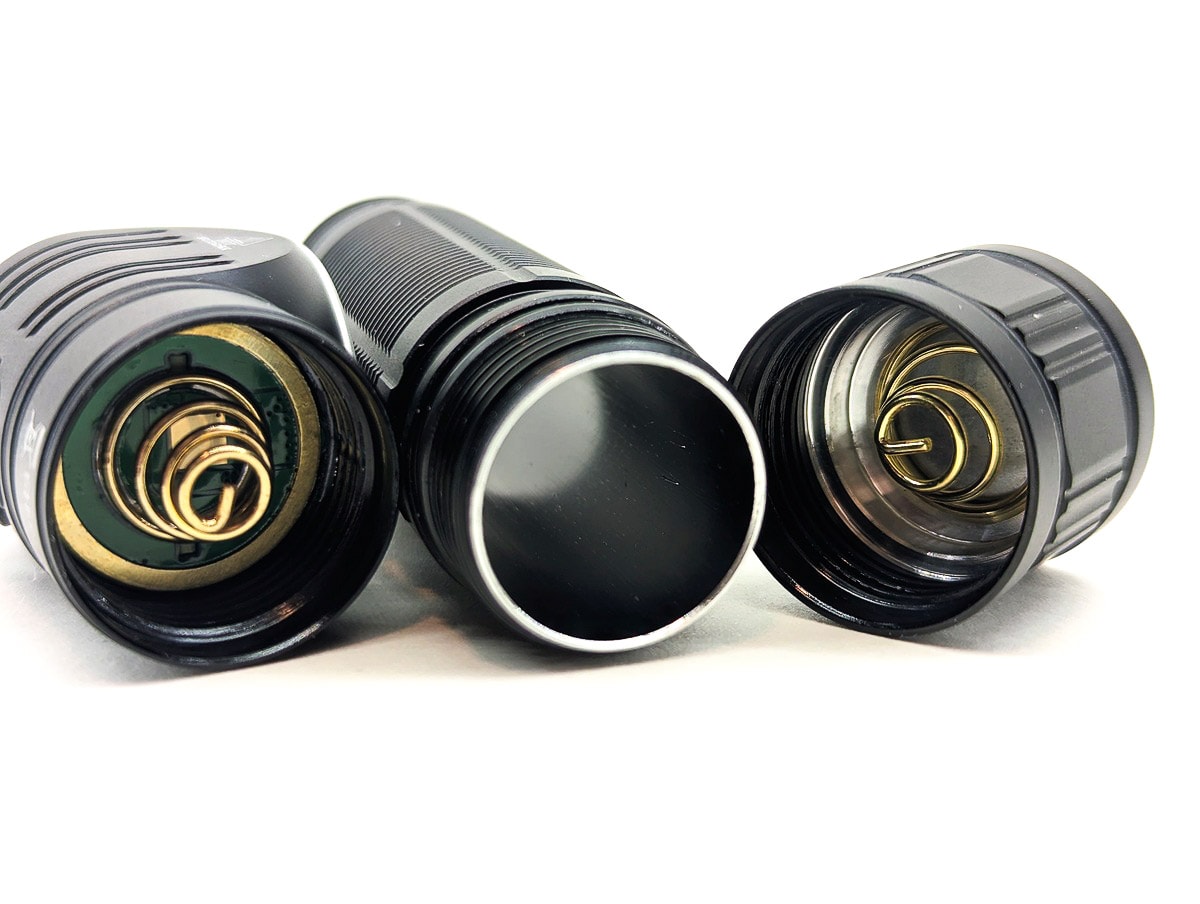
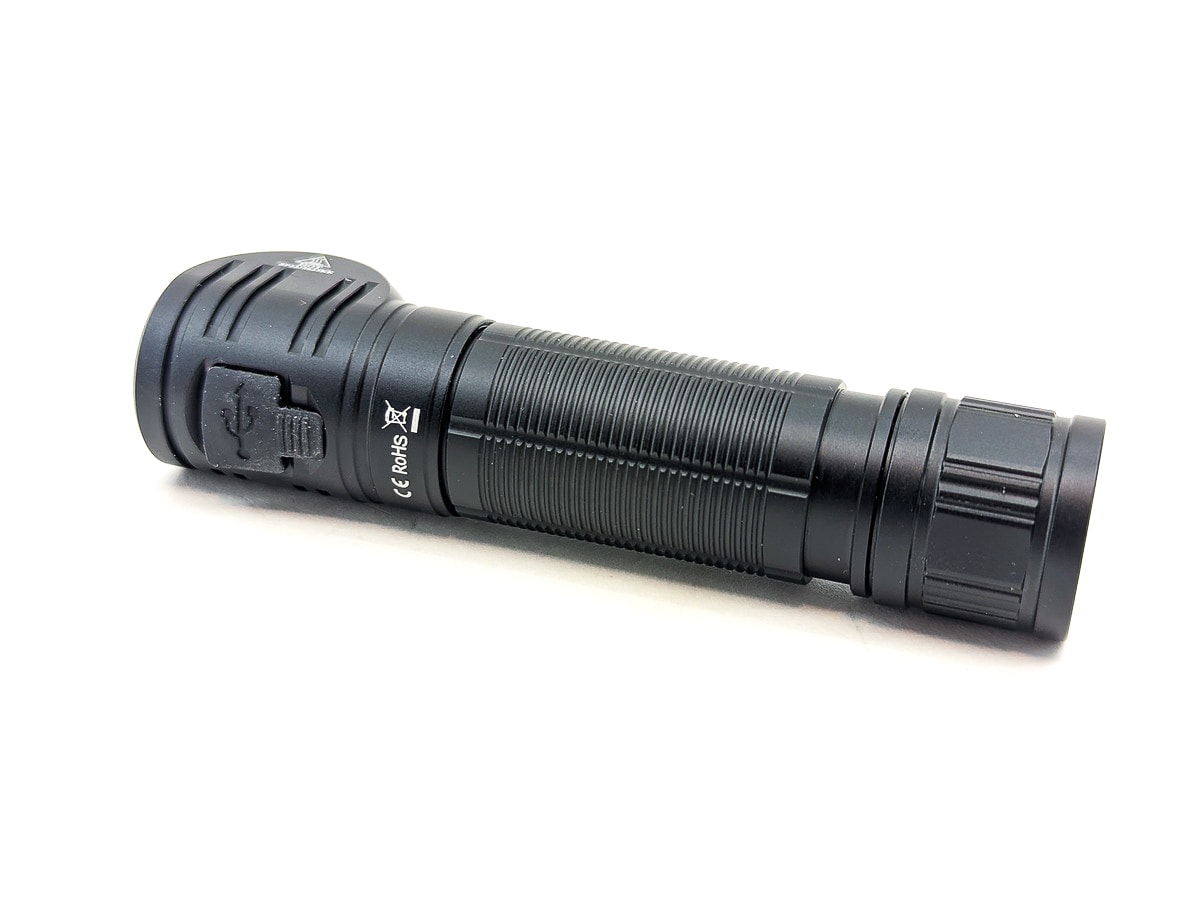
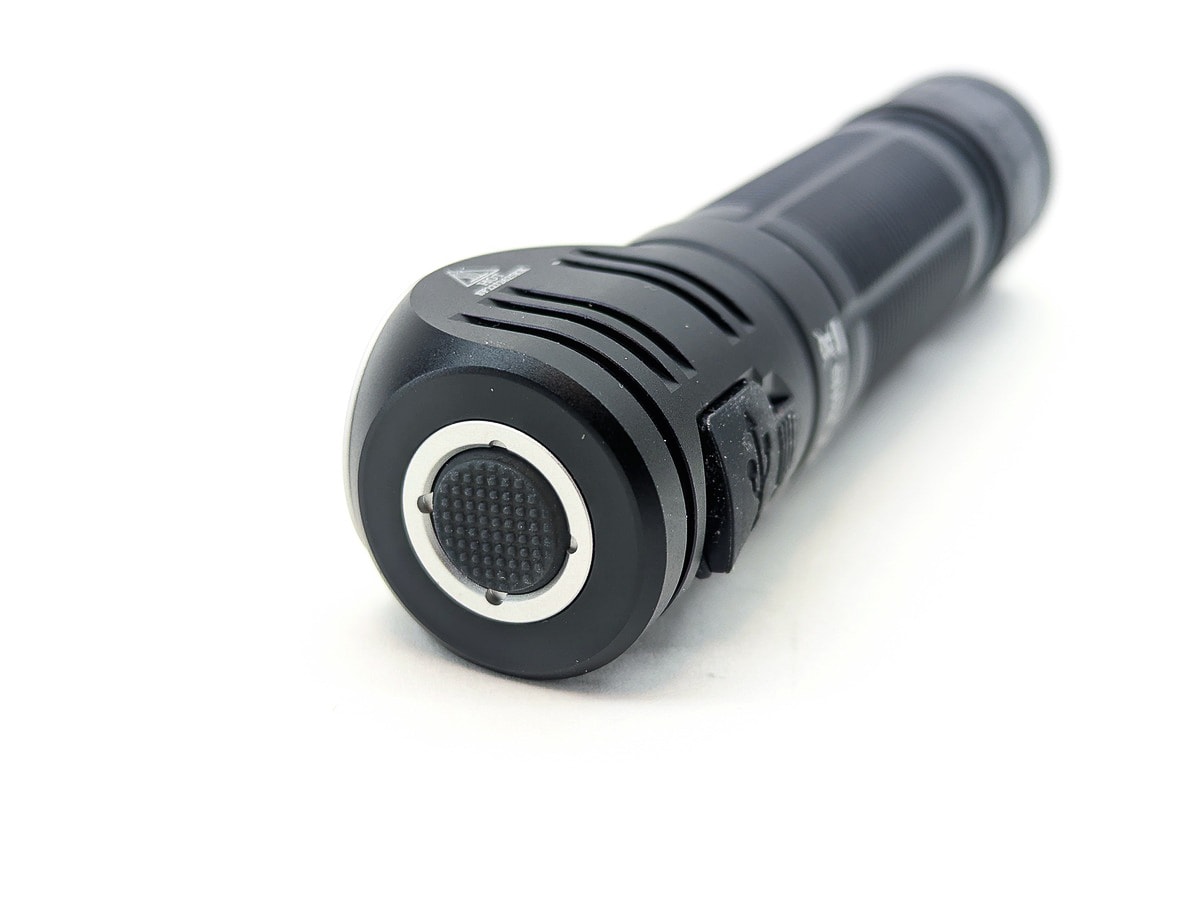

LED, Lens, Bezel, Beam, and Reflector
The Sofirn HS40 uses a Luminus SST40 LED, which is one of several things that sets it apart from the Sofirn SP40 headlamp (which uses XPL or LH351D LEDs). Sofirn gives us two options for the SST40: 6500K and 5300K offerings. It’s great to have options, and I was a fan of the SST40 at one point. But it’s infamy for poor tint is no joke. I’m colorblind and I still cringe when pointing this LED at a white wall.
The LED is centered in a shallow, light orange peel reflector and covered by a piece of glass, all of which is held in place by a silver-colored retaining ring. The LED and reflector make a soft, medium-sized hotspot and wide spill.
Opple Light Master readings from Turbo at 3 meters:
- CCT: 4453K
- CRI: 56.7 Ra
- DUV: +0.0159
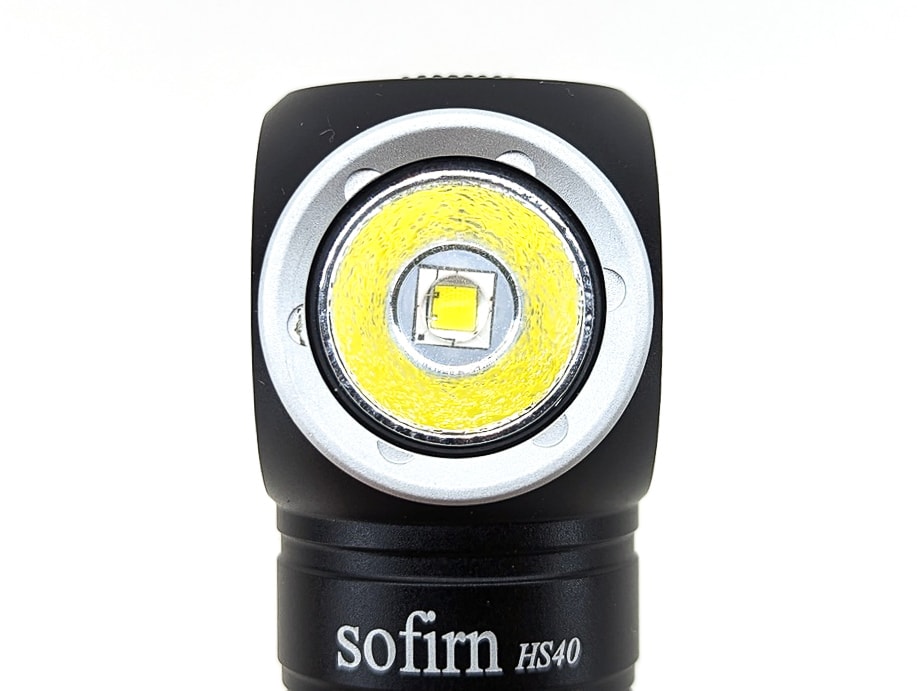
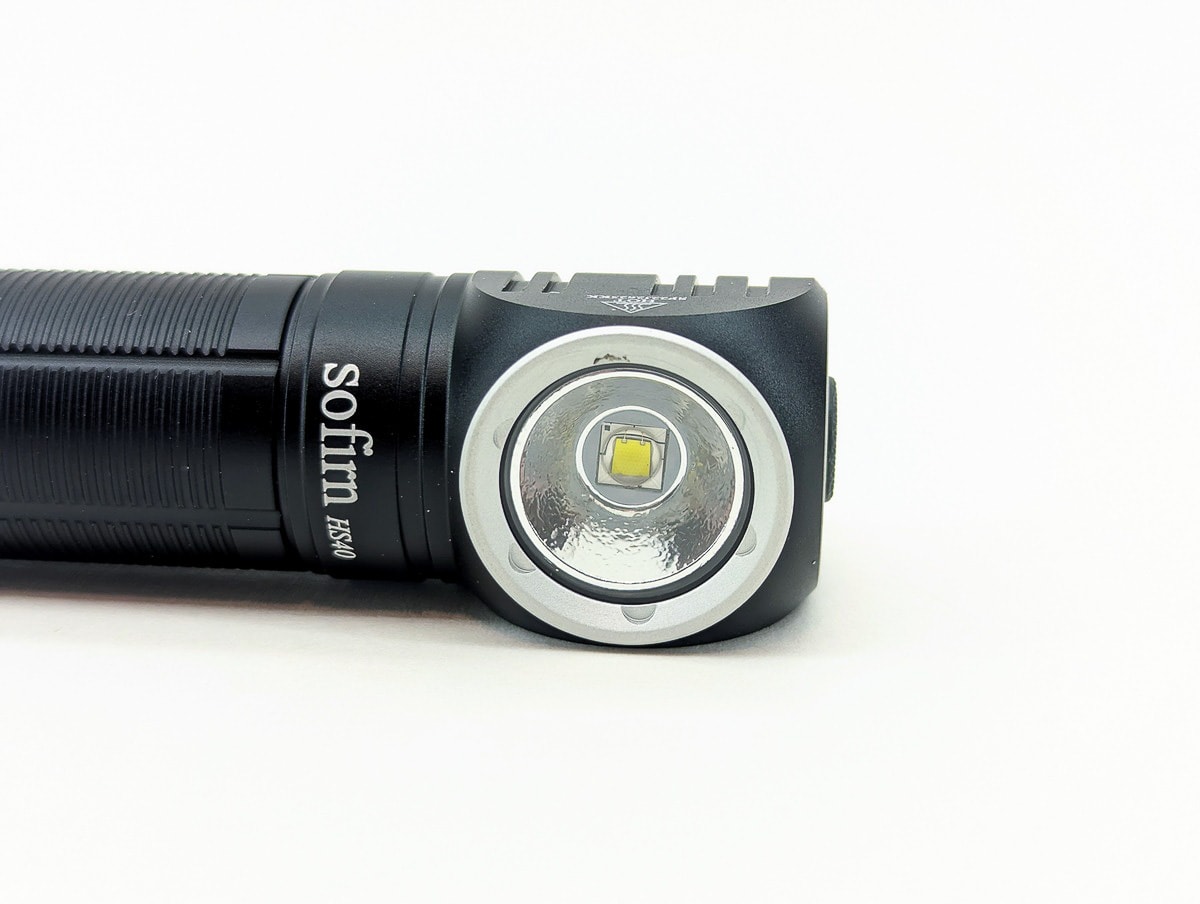
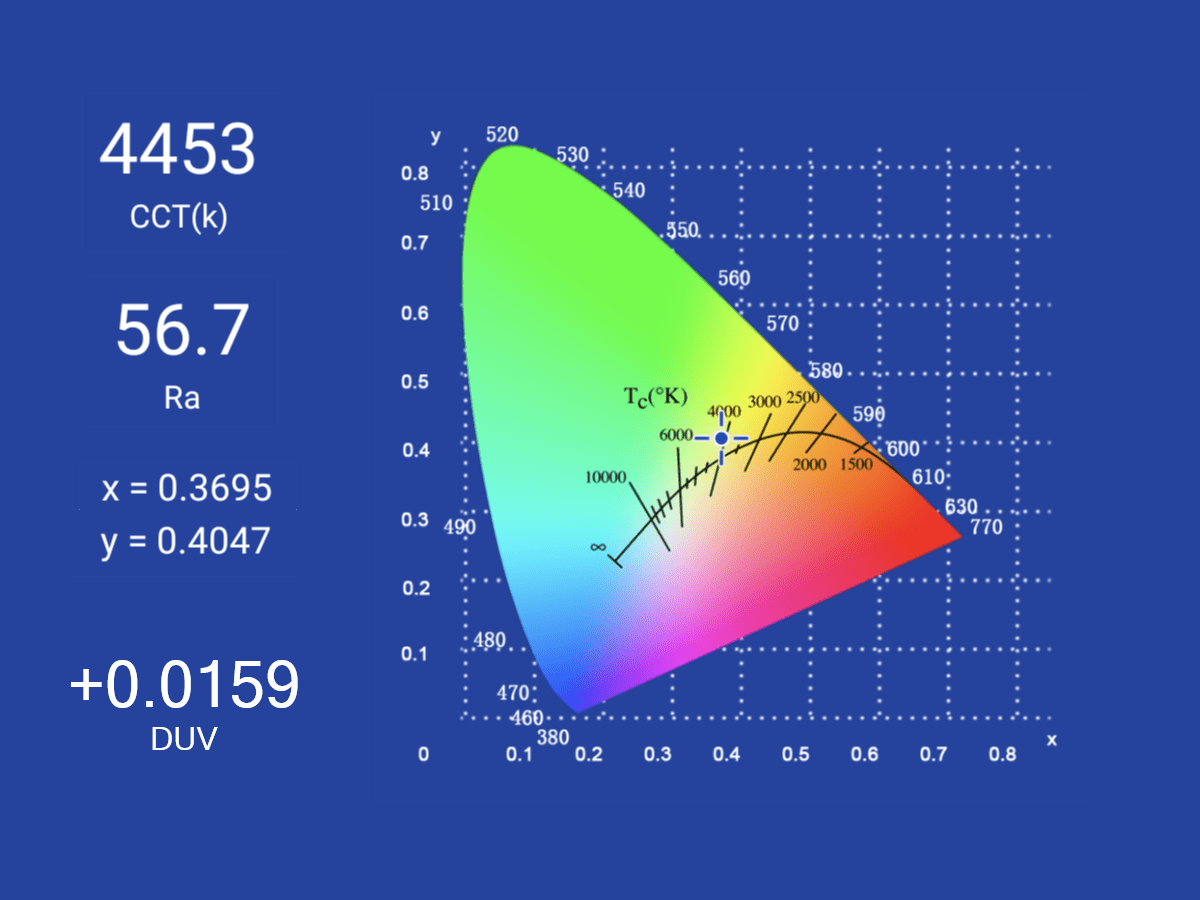
Dimensions and its competition
Dimensions:
| Sofirn HS40 | Millimeters | Inches |
|---|---|---|
| Length | 111 mm | 4.4 in |
| Head diameter | 26 mm | 1.0 in |
| Body diameter | 25 mm | 1.0 in |
Dimensions are rounded to the nearest millimeter, and to the nearest tenth of an Inch.
Weight:
| Sofirn HS40 | Weight in grams | Weight in oz |
|---|---|---|
| Without battery (no strap/clip): | 71 g | 2.5 oz |
| With battery (no strap/clip) | 118 g | 4.2 oz |
Weight is rounded to the nearest gram, and to the nearest tenth of an Oz.
Flashlight size comparison to other headlamps:
Check out our list of the best headlamps for more competitors.
Group 1: Sofirn SC31 Pro, Sofirn HS40, Sofirn SP10 Pro
Group 2: ThruNite TH30 V2, Sofirn HS40
Group 3: Speras M2R-35, Sofirn HS40 (with 18350 tube)

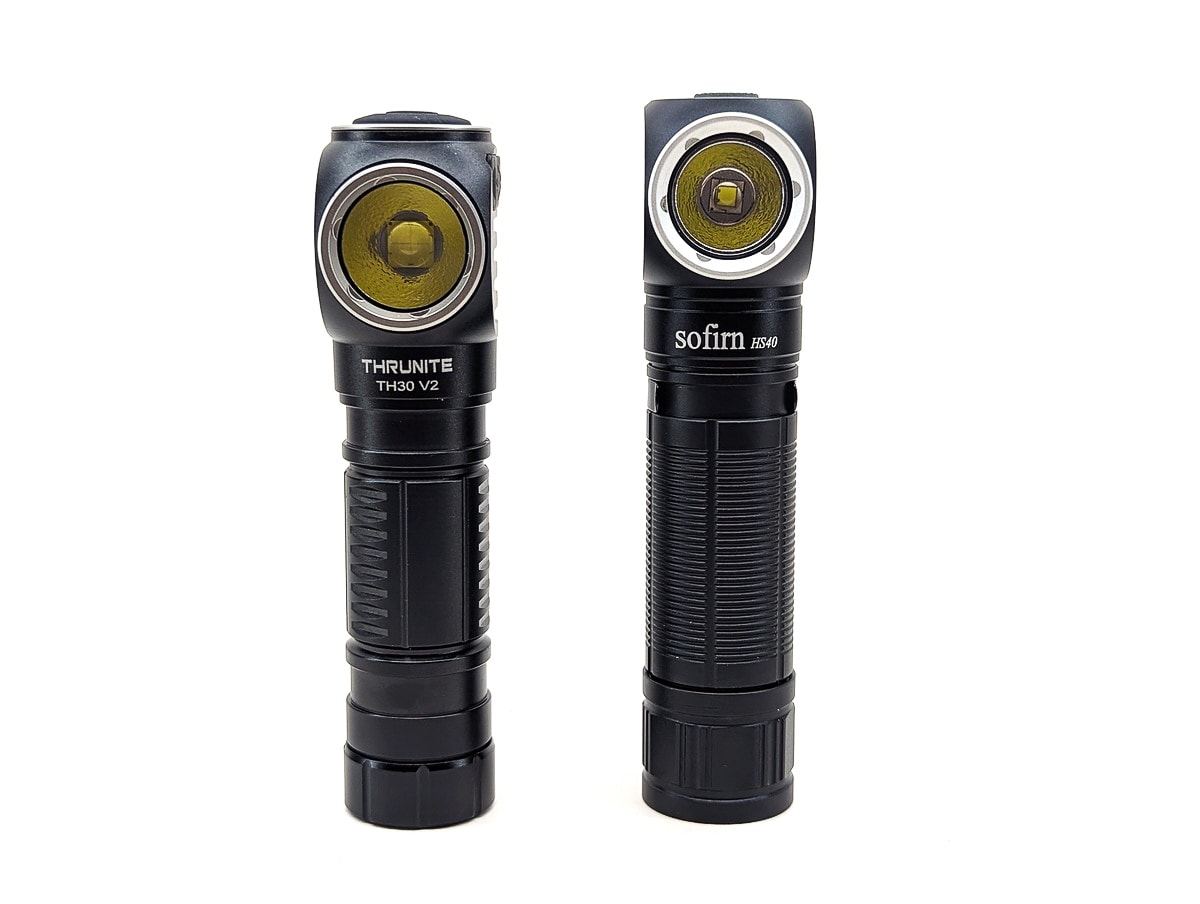
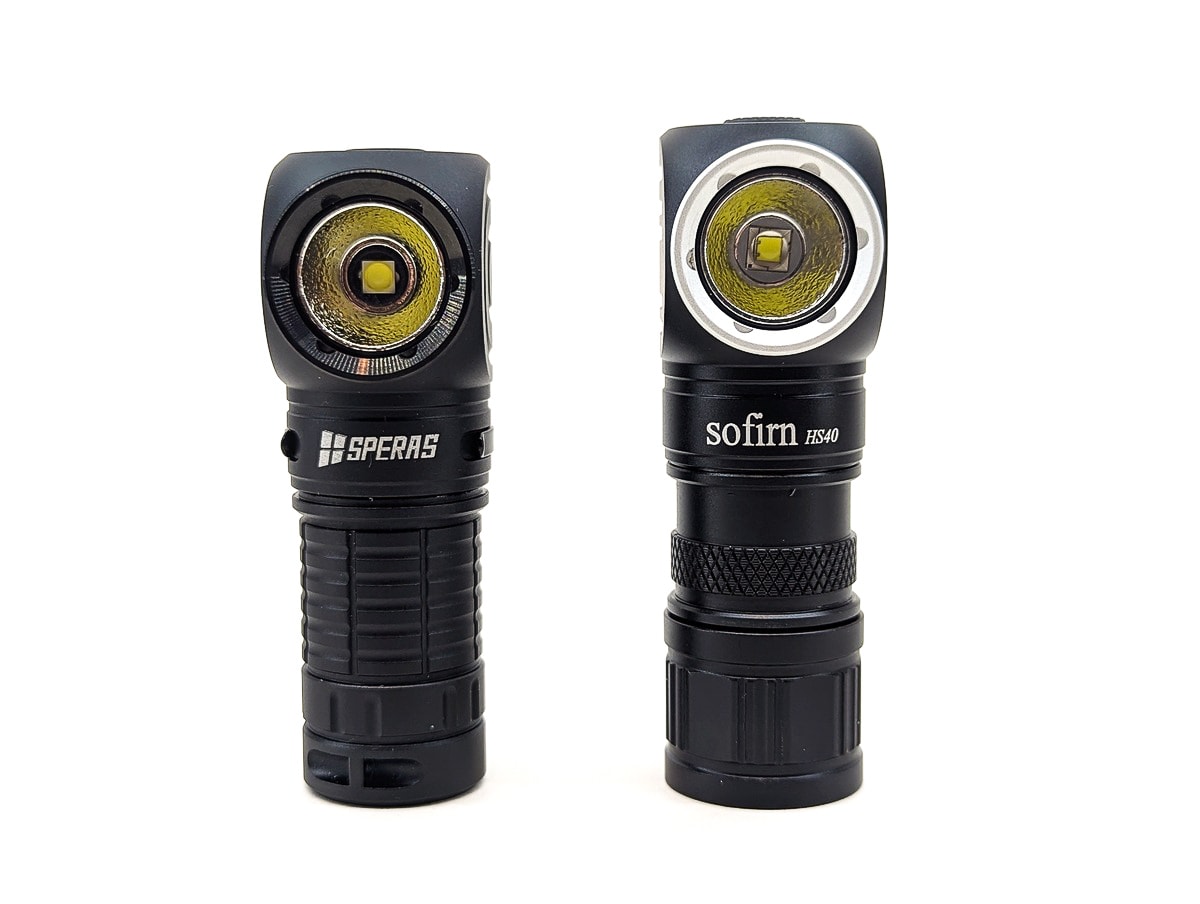
Sofirn HS40 UI: User Interface and Driver
Available modes:
- Moonlight, Low, Medium, High, Turbo
Available blinky modes:
- Strobe, SOS, Beacon
From OFF:
- Press and hold: Moonlight
- Single click: turn On
- Double click: Turbo
- 3 clicks: Strobe
- 4 clicks: Lockout
From ON:
- Press and hold: change brightness
- 1 click: turn Off
- Double click: Turbo
- 3 clicks: Strobe
- 4 clicks: switch between Group 1 (stepped modes) and Group 2 (ramping)
- etc.
Mode memory:
- Yes
Shortcuts:
- To Low: press and hold 1 second from Off
- To Turbo: double click from Off or On
- To Strobe: triple click from Off or On
Low voltage warning:
- Brightness steps down as battery depletes
Strobe/blinkies
- Triple click from Off or On to access Strobe
- Double click from Strobe to get to SOS
- Double click from SOS to get to Beacon
- Single click at any point to exit to the previous mode
Lock-out mode:
- 4 clicks from Off goes to Lockout
- While locked out, momentary Moonlight is available
- 4 clicks while locked out unlocks the light
PWM
- No PWM was detected in any mode (using a photodiode and multimeter set to Hz)
Additional/summary info on the UI:
- This is a really good UI that sticks to the basics with just enough extras: shortcuts and choice between ramping & stepped modes
Sofirn HS40 Charging and batteries
In its “normal” form, the Sofirn HS40 uses a single 18650 battery. My sample arrived with a Sofirn-branded 3000 mAh button-top cell inserted into the light with a protection disc to keep it from accidentally turning on. The HS40 also came with Sofirn’s 18350 tube, which is a welcome addition. While I may not use the smaller battery arrangement very often, some people like to have their headlamps as light as possible (at the expense of output/runtime), and using a 18350 is a good way to achieve that.
Charging is another aspect that Sofirn improved over the previous SP40 model. The SP40 used micro-USB and topped out at a 1-amp charge rate. The HS40 uses USB-C (thank goodness) and up to a 2-amp charge rate. That seems like a reasonable claim. In my testing, I saw a 8.2 watt (1.6 amps at 5.1 volts) charge rate, which brought a depleted cell up to a full charge in 2 hours and 1 minute. That seems pretty good for a 18650 cell.
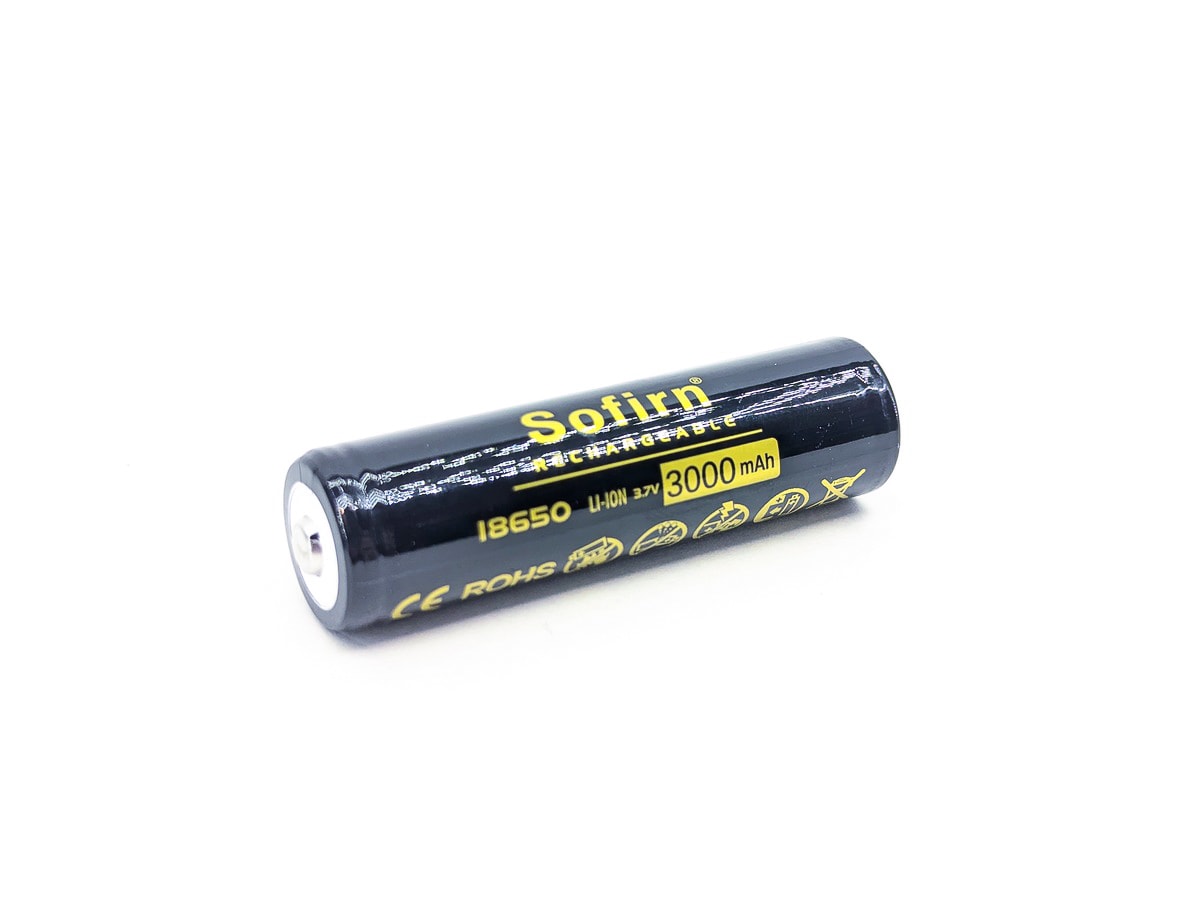


Performance test
Lux was measured by a UNI-T UT383 BT at 5 meters. Lumens were measured in a homemade lumen tube using a VEML7700 sensor, calibrated with a Maukka calibration light. The included Sofirn-branded 18650 battery was used.
Lumen measurements (for each mode)
| Mode | Amps at start | Specified | turn on | 30 sec | 10 minutes |
|---|---|---|---|---|---|
| Moon | 6 mA | 1 | 1.3 lm | 1.3 lm | – |
| Low | 26 mA | 10 | 12 lm | 12 lm | – |
| Med | 0.5 A | 300 | 241 lm | 240 lm | 239 lm |
| High | 1.4 A | 800 | 640 lm | 634 lm | 615 lm |
| Turbo | 4.0 A | 2000 | 1418 lm | 1335 lm | 558 lm |
| Turbo at 3.6V | – | – | 991 lm | 942 lm | – |
Parasitic drain:
- 7 µA
There are a few things worth noting about the output tests. First and foremost, I didn’t measure anywhere near the 2000 claimed lumens. I think one part of that is I have the NW (5300K) version. Warmer CCT LEDs almost always put out less light than their CW counterparts. I’m sure that Sofirn published specs using the 6500K SST40 to do their measurements. And I’m sure they could have been a bit “optimistic” about their lumen claim as well.
The other thing worth mentioning: that temperature regulation. This has popped up a few times on Sofirn lights. It seems to erratically search for a suitable output as it looks to regulate the temperature. While I absolutely do not like this, in person it’s not quite as bad as the graph might make you think. In the High test, each one of those up-and-down cycles is spread out over 2 minutes. That makes it a pretty gradual change.
Sofirn HS40 battery Life: Runtime graphs
| Mode | Specified | Measured runtime ANSI | Time till shut off |
|---|---|---|---|
| Moon | 400h (16.7 days) | – | – |
| Low | 220h (9.2 days) | – | – |
| Med | 8h | 5h 35min | 9h 10min+ |
| High | 2h | 2h 24min | 3h 12min+ |
| Turbo | 2h 30min | 2h | 6h 5min+ |
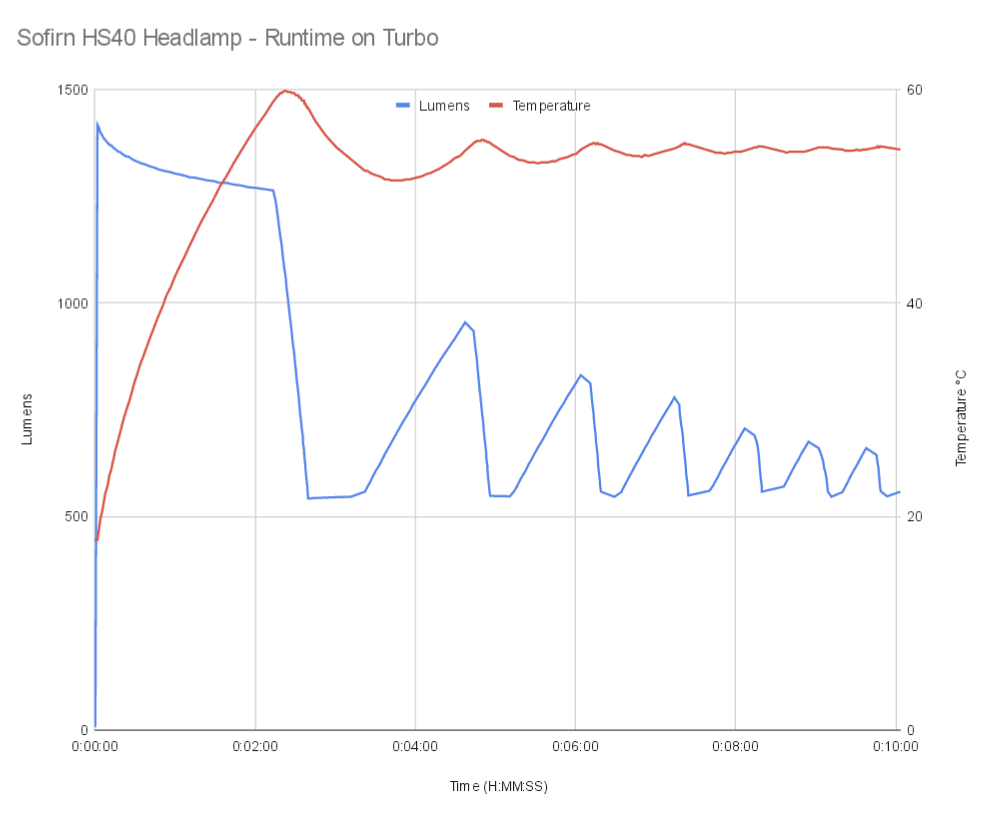
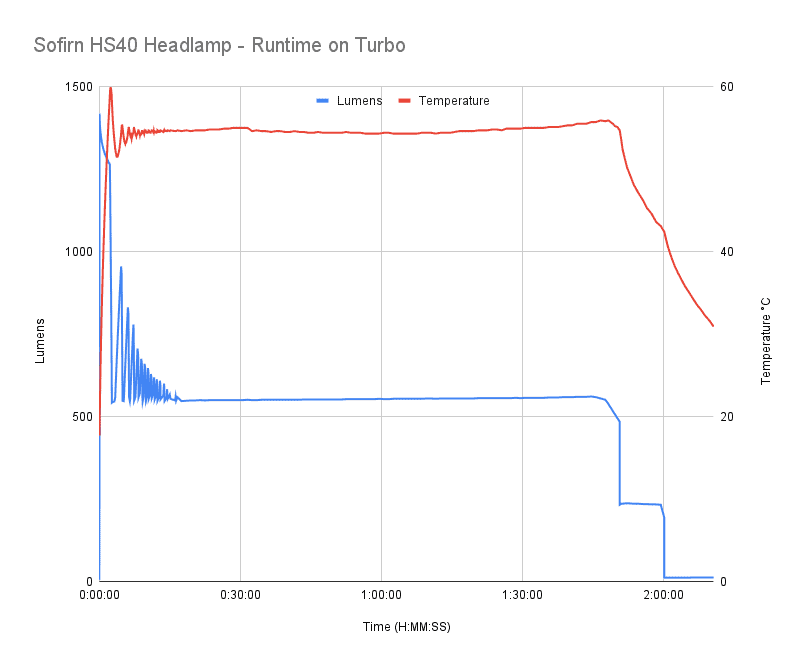
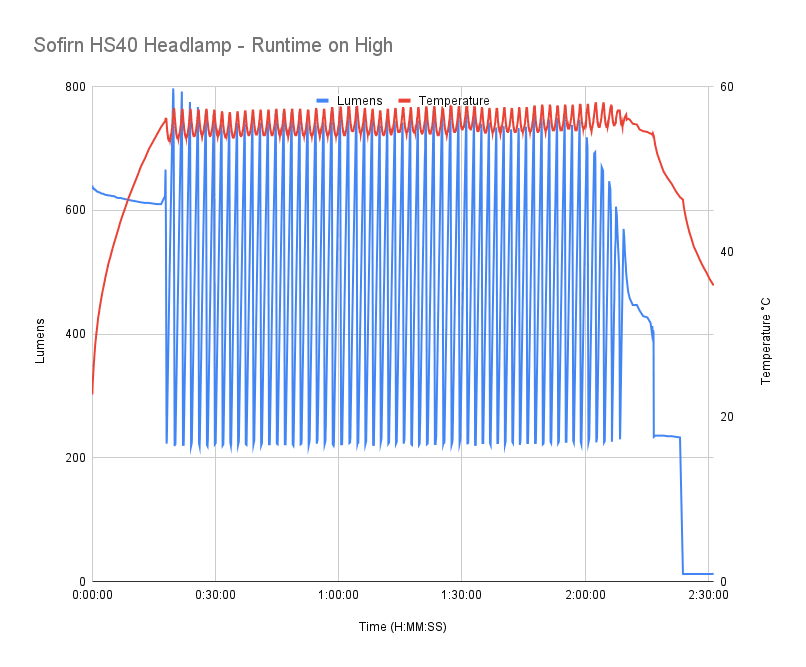

After the HS40 steps its way down to Low mode (12 lumens) as the battery is running out, it keeps going for hours. When doing the Turbo runtime, I stopped the test after it had been putting out 12 lumens for 4 hours. At that point, the battery measured 2.91 volts. I observed similar behavior in the other tests, and stopped those after a long time at 12 lumens as well.
About ANSI FL1 standards: The runtime is measured until the light drops to 10% of its initial output (30 seconds after turning on). This does not mean that the flashlight is not usable anymore. The last column shows how long the light actually works till it shuts off. If there is a + symbol, it means that the test was stopped at that particular point, but the light was actually still running. This happens on certain occasions, with certain drivers, firmware, or batteries.
Peak beam intensity and beam distance measurements
Intensity was measured at 5 meters after being turned on for 30 seconds. A UNI-T UT383 BT lux meter was used.
| Mode | Specified | Candela measured | Meters | Yards |
|---|---|---|---|---|
| Low | 107 cd | – | – | – |
| Medium | 1150 cd | 1050 | 65 m | 71 yd |
| High | 4137.5 cd | 2750 | 105 m | 115 yd |
| Turbo | 7625 cd | 5625 | 150 m | 164 yd |
After seeing the lumen readings compared to spec, the shortcomings of the intensity readings are no surprise. It’s entirely possible that the CW 6500K version would hit the claimed 7625 cd, but this NW version does not.
About peak beam ANSI: Peak beam distance according to ANSI FL1 standards: The calculated value of distance in meters at which the flashlight produces a light intensity of 0.25 lux. (0.25 lux is about the brightness of a full moon shining on an object). The columns ‘Meters’ and ‘Yards’ use rounded numbers.
Beamshots
Beam shots of the building are taken at 30 m (33 yd) using a Pixel 7 set to ISO 800 with 1/10 second exposure time
Beamshots of the following flashlights compared:
- Sofirn HS40
- Wuben H1
- ThruNite TH30 V2
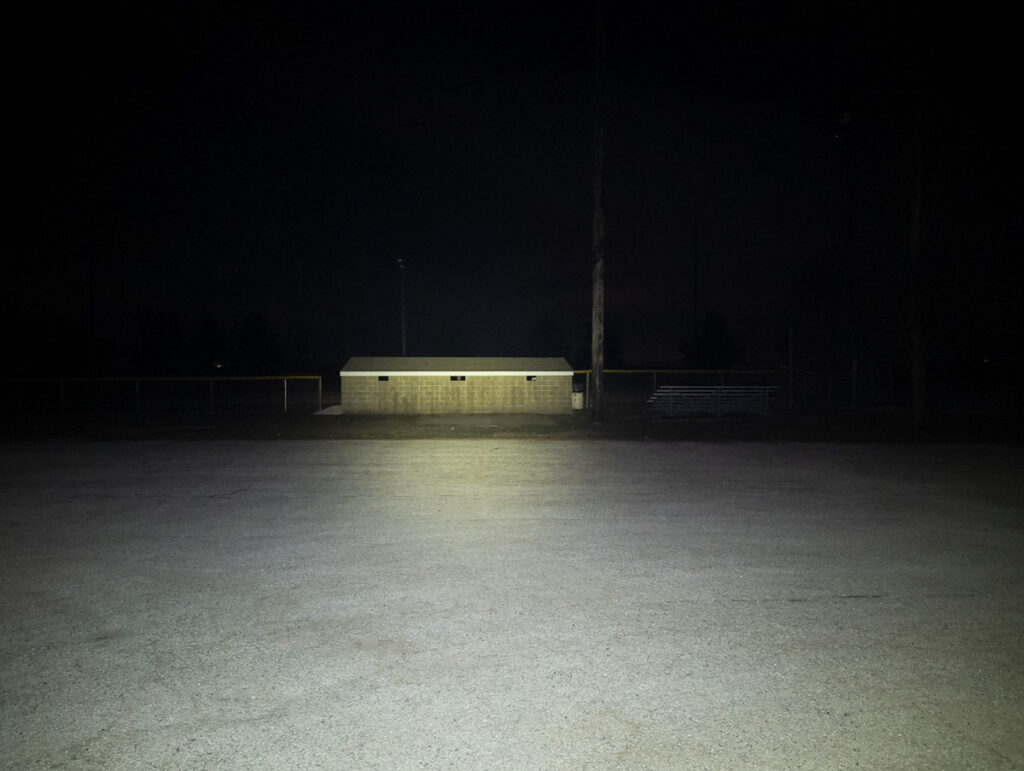

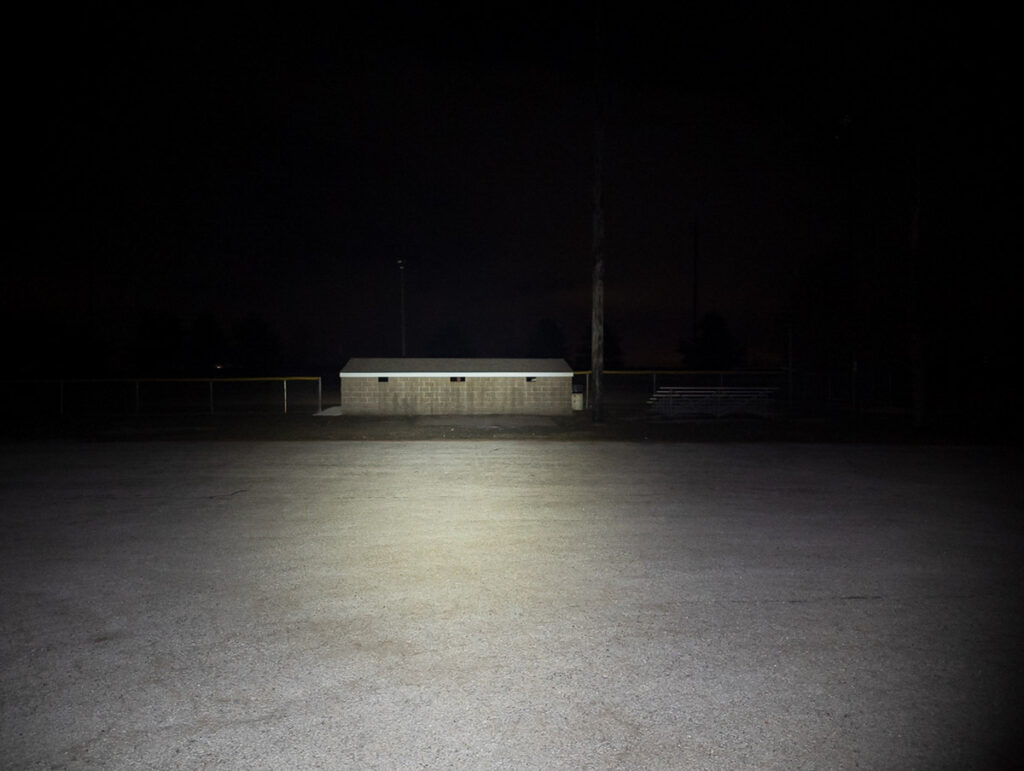
Disclaimer: This flashlight was sent to me for review at no cost by Sofirn. I have not been paid to review, nor have I been holding back on problems or defects.
Final Verdict
Pros
- Nice updated design compared to the SP40
- Well rounded, yet simple, UI
- Low output & efficient Moonlight mode
- No PWM
- Well regulated lower modes
- USB-C charging
- 18350 tube included
- Magnetic tailcap
Cons
- Green tint
- Wild output swings in High mode
- Misses lumen and throw specs (at least the NW version does)
Explanation on star ratings:
1: Avoid: a match would be a better choice – 2: Poor: significant defect or issues; almost unusable – 3: Average: some defects or issues; but still usable 4: Good: recommended (minor issues) – 5: Great: highly recommended

3.5 stars: ★★★⋆
There’s a lot to like about the Sofirn HS40 headlamp. It can be purchased as a nice kit, complete with battery, charging cable, and a host of accessories for what I consider to be a very reasonable asking price. The UI is great, and it’s nice to have a full-featured yet simple UI – complete with Moonlight mode, good shortcuts, and even a momentary mode in Lockout. As we’ve seen before with some Sofirn lights, High mode struggles to find a suitable output to stabilize the temperature. And the SST40? It’s certainly not for you “tint snobs” out there. But if you’re willing to look past the tint (or swap the LED), I think Sofirn has the making of a really nice headlamp here – and strides better than their old SP40.
Buy Sofirn HS40 here
1lumen selects and reviews products personally. We may earn affiliate commissions through our links, which help support our testing.